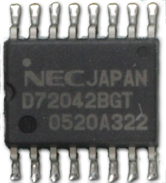| Communication protocol | |
 μPD72042B protocol controller made by NEC | |
| Purpose | Communication between equipments within a vehicle or a chassis. e.g.) Car audio,Vending machine,etc. |
|---|---|
| Developer(s) | Renesas (formerly NEC Electronics) |
| Introduction | 1993 |
| Based on | PWM (pulse-width modulation) Base clock: 6.000 MHz (6.291 MHz) |
| OSI layer | "Physical" and "Data link" layer |
| Hardware | IEBus controller & Transceiver |
IEBus (Inter Equipment Bus) is a communication bus specification "between equipments within a vehicle or a chassis" of Renesas Electronics. It defines OSI model layer 1 and layer 2 specification. IEBus is mainly used for car audio and car navigations, which established de facto standard in Japan, though SAE J1850 is major in United States.[1]
IEBus is also used in some vending machines, which major customer is Fuji Electric.[2]: 244(42)
Each button on the vending machine has an IEBus ID, i.e. has a controller.
Detailed specification is disclosed to licensees only, but protocol analyzers are provided from some test equipment vendors.[3]
Its modulation method is PWM (Pulse-Width Modulation) with 6.00 MHz base clock originally, but most of automotive customers use 6.291 MHz, and physical layer is a pair of differential signalling harness. Its physical layer adopts half-duplex, asynchronous, and multi-master communication with carrier-sense multiple access with collision detection (CSMA/CD) for medium access control.[4]: 7 It allows for up to fifty units on one bus over a maximum length of 150 meters.[4]: 7 Two differential signalling lines are used with Bus+ / Bus− naming,[4]: 5 sometimes labeled as Data(+) / Data(−).
It is sometimes described as "IE-BUS", "IE-Bus," or "IE Bus," but these are incorrect. In formal, it is "IEBus." IEBus® and Inter Equipment Bus® are registered trademark symbols of Renesas Electronics Corporation, formerly NEC Electronics Corporation, (JPO: Reg. No.2552418[5] and 2552419,[6] respectively).
- ^ Goto, Masahiro; Tokuda, Akio; Tatemoto, Hirofumi (September 2011). "車載通信ネットワークの標準化の動向: FlexRayとMOSTを中心に" [Trend of Standardization in Automotive Communication Network System Case: FlexRay and MOST.] (PDF). Social System Study (in Japanese). 23: 159–173. ISSN 1345-1901.
- ^
Nakano, Kazukiyo; Kawakami, Koji; Tachi, Yuji (2002-04-10). "デュアル店舗機" [Vendor Showcase for Dual-Performance Stores] (PDF). Fuji Electric Journal (in Japanese). 75 (4): 244 (42).
Fig.5 ISS: IE-BUS interface
- ^ "IE-Bus Main Page". www.tessera.co.jp.
- ^ a b c Cite error: The named reference
uPD6708-UMwas invoked but never defined (see the help page). - ^ "Trademark search: Reg. 2552418" (PDF). www.j-platpat.inpit.go.jp (in Japanese). Japan Patent Office. 1992-09-04.
- ^ "Trademark search: Reg. 2552419|J-PlatPat" (PDF). www.j-platpat.inpit.go.jp (in Japanese). Japan Patent Office. 1992-09-04.